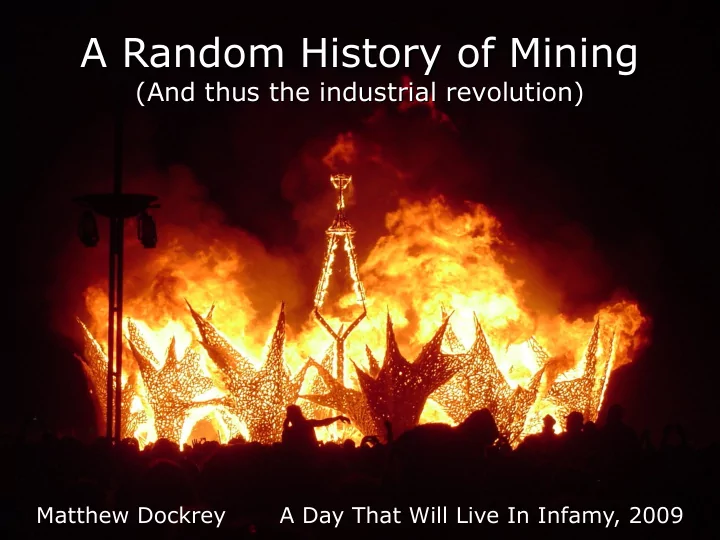

A Random History of Mining A Random History of Mining (And thus the industrial revolution) (And thus the industrial revolution) Matthew Dockrey A Day That Will Live In Infamy, 2009
The Neolithic The Neolithic Flint, Obsidian, Chert, some others. Why these?
Conchoidal Fractures Conchoidal Fractures Image courtesy of sterlingsculptures.com
Conchoidal Fractures II Conchoidal Fractures II Image courtesy of sterlingsculptures.com
Conchoidal Fractures III Conchoidal Fractures III Image courtesy of sterlingsculptures.com
Flintknapping Flintknapping Image from texasbeyondhistory.net
Grime Grime Graves Graves Image discourtesy of English Heritage
Image discourtesy of English Heritage
Holy hell, can you freaking Holy hell, can you freaking imagine? imagine? Remember, neolithic . No metals! Antler tines and leather bags. That's it! Soil and soft rock only, obviously. Trade networks spanned thousands of miles.
SRS BSNS SRS BSNS
The great void The great void The next couple thousand years, kind of mysterious Not much left, and there wasn't much written about it Until...
De Re Metallica De Re Metallica Premier manual of mining and metallurgy for hundreds of years (1556) Georg Bauer => Georgius Agricola Joachimsthal and Chemnitz (Joachimsthal => Thaler) First English translation in 1912 by Herbert and Lou Henry Hoover Oddly superstitious
Water, water everywhere... Water, water everywhere... If you dig deep enough, most holes will eventually fill with water. Can drain (with an adit) or pump. Both work better in mountains...
Water wheels? Eh. Water wheels? Eh. Another source of power was needed People had been speculating about (and sometimes even building) steam engines since the aeolipile in ~250BC But only as a toy or curiosity, never trying to solve a real problem Until...
Thomas Savery Thomas Savery “A new invention for raiseing of water and occasioning motion to all sorts of mill work by the impellent force of fire, which will be of great use and advantage for drayning mines, serveing townes with water, and for the working of all sorts of mills where they have not the benefitt of water nor constant windes.” Patent (without description!) 1698 The Miner's Friend; or, An Engine to Raise Water by Fire (1702)
First to use the term “horsepower” Slow, inefficient Could only lift about 40 feet Only ever really used in gardens Tended to explode But it (kind of) worked!
Thomas Newcomen Thomas Newcomen Ironmonger, preacher Not fancy enough of a guy for us to have a picture or know much about him, sadly Practical, good at tinkering Utterly screwed by intellectual property laws AND Royal Society snobbery
The The Newcomen Newcomen Atmospheric Atmospheric Engine Engine (1712) (1712)
Video: Industrial Revelations, Episode 1
Problems Problems Still not very efficient Horrible boiler design Hot-cold-hot-cold cylinder Lack of precision machining was limiting
James Watt James Watt Added condenser, other refinements: 1765 Note: 50 years after Newcomen! Better cylinder design possible due to improvements in machining Another intellectual property bastard Held back high pressure steam as long as possible Not really deserving of an SI unit, if you ask me
So... So... Can now drain deep mines Can also hoist ore and spoil as well as water But what about people?
The Man Engine The Man Engine Already have pump rods going up and down, so why not ride them? Started early, 17 th century? Continued into the early 20 th century Levant disaster, 1919, 31 people killed
Animation: http://www.tinmining.co.uk/private.htm Video: http://www.prosieben.de/wissen/multimedi a/videos/videoplayer/58030/
In Conclusion In Conclusion It is hard to separate the development of mining technology from technology in general We've done some pretty crazy stuff to get at minerals, even before the monster devices of the last 100 years Miners like beer, right? Let's go honor their lifestyle.
The End! The End! This image from Astronomy Picture of the Day, many others from Wikipedia, duh.
Recommend
More recommend